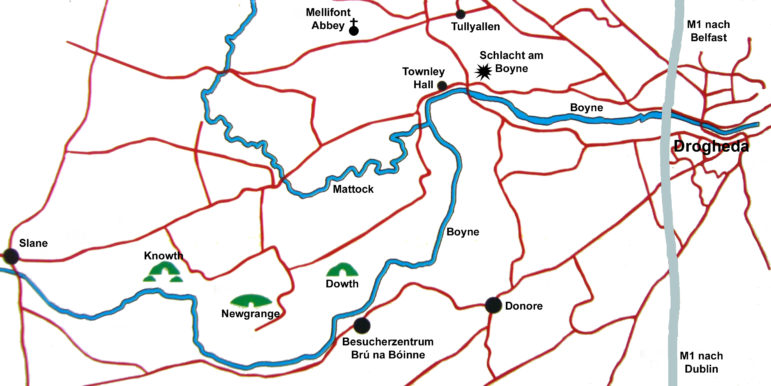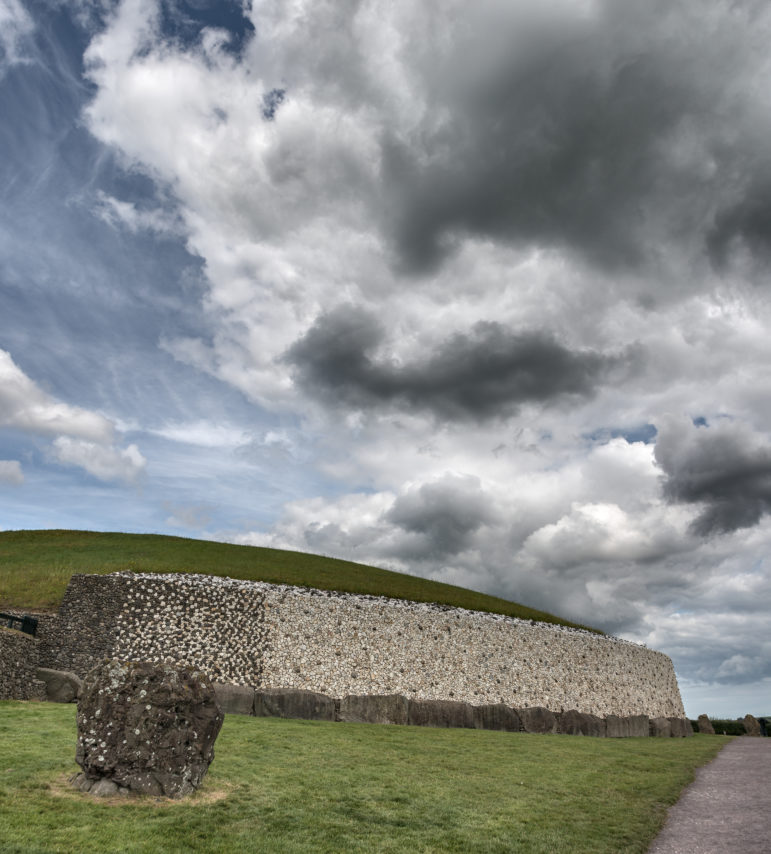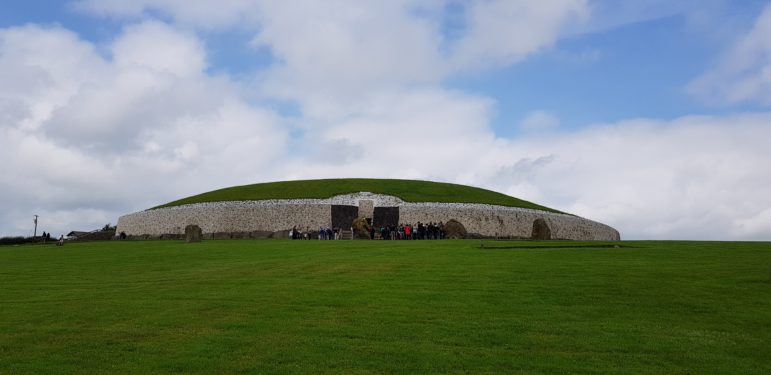DUBLIN – In August 2019, archaeologists from University College Dublin reported a major find in the Brú na Bóinne area of County Meath, Ireland. Brú na Bóinne, Irish (Gaelic) for the “Palace of the Boyne,” refers to land on the north side of the River Boyne, enclosed by a bend in that river. They found evidence of almost 40 unknown monuments. Their structures indicate a Neolithic origin.
The Brú na Bóinne has 93 known Neolithic monuments in an area of 780 hectares (3.1 square miles). Already known structures at that site include the famous passage tombs of Newgrange, Knowth, and Dowth. In the Neolithic, Brú na Bóinne formed a ceremonial complex of multiple henges, passage graves, and other structures.

Map of Brú na Bóinne – Image credit: de:Benutzer:Emkaer – WikiCommons
The most interesting of these new-found monuments appears to align with the Winter Solstice sunrise. It lies near the Newgrange passage tomb, also aligned with the Winter Solstice. Irish Central described it as a “rectangular arrangement of wooden posts” that enclosed a passageway.
Newgrange
Archaeologists have not yet excavated any of these new-found sites. They have studied, however, the passage tomb Newgrange. In a passage tomb, a long, narrow passage connects the entrance with an inner burial chamber.
Newgrange is a circular structure. It measures 76.2 m (250 ft) across and 12.9 m (40 feet) high. As the sun rises on the Winter Solstice, sunlight enters through a “skylight” or “roofbox” above the entrance. The passage, 18.3 m (60 ft), links the entrance with a cross-shaped inner burial chamber. At dawn, the sunlight of the Winter Solstice illuminates the passage and inner chamber for about 15-20 minutes.

Newgrange – Image Credit: Giorgio Galeotti – WikiCommons
Farming began in this area around 4500 B.C.E. People built Newgrange between 3100 and 2900 B.C.E. That would make it roughly contemporary with Stonehenge and the Pyramids of Egypt. People built Stonehenge between 3000 and 2000 B.C.E. People built the Pyramids between 2700 and 1700 B.C.E. Though none of these dates are known with certain.
During the Bronze Age, 1300 to 700 B.C.E., Newgrange fell out of use for unknown reasons. Afterwards, nature reclaimed the area and buried it. Only in the late 17th century did people become aware of it. Newgrange remained unexcavated until 1975. In 1983, UNESCO designated the Brú na Bóinne as a world heritage site.

Newgrange – Image credit: Conorohara – WikiCommons
Newgrange has its controversies. Archaeologist Michael Gibbons has challenged the historical accuracy of the reconstruction in the 70s. Gibbons has argued that in that reconstruction, the skylight or roof-box was added. Other people have questioned the historical accuracy of its quartz outer wall. Dr. Richard Hensey, author of “First Light: The Origins of Newgrange,” partially agreed with Gibbons. Hensey has said that skylight’s position was “elevated” at that time, not that it was “added.”
Drought and high tech
During the drought of 2018, “recreational” drone photographers noticed geometric patterns in fields. They reported over such 70 sightings to the Irish National Monuments Service. Dr. Steven Davis, lead archaeologist, reported that they used the latest technology to examine these sightings. They used radar imaging, airborne laser scanning, and large-satellite-based remote sensing techniques.
The German government had already funded the Boyne to Brodgar Project. That project is examining Neolithic sites in the Boyne Valley in Ireland, and those in the Orkney Islands in Scotland. The University College of Dublin (UCD) and the Romano-Germanic Commission are collaborating on the project. Dr. Steven Davis works with the UCD.
Anthony Murphy of Mythical Ireland was one of those recreational drone photographers who first found evidence of these structures. While not an academic, he has made an extensive study of the Boyne valley and its place in Irish mythology.
According to Murphy, the bend of the River Boyne forms a natural amphitheater. Newgrange sits atop a ridge on the crest of a hill. Nearby, a triple palisade of wooden posts stood guard and curved along the ridge. Murphy suspects that this palisade may be part of a giant henge, a circular structure surrounded by a bank and ditch.
Murphy considers Dowth, Knowth, and Newgrange to be one aspect of, “a much more complex and impressive monumental complex. The monument complex wasn’t just concerned with death, and housing the dead. There are huge ritual spaces that likely encompassed significant gatherings and events, possibly associated with important calendar dates. The possibility must be considered that the Great Palisade served as a barrier of sorts between the ritual (and perhaps celebratory) spaces and the more somber spaces of the passage-tombs, where the intimate and exclusive ceremonies around the bringing of the bones of the ancestors to the stone chambers took place.”
Murphy speculated that some of these henges at Brú na Bóinne may have functioned as “oenaige.” That Irish word refers to “historical fairs, but with political and ritual overtones.” He stressed that these oenaige are “not isolated monuments but rather are parts of complexes that include other monuments of various sorts.”
These Neolithic complexes speak to many modern Pagans. Yet we know even less about the Neolithic people that built them than we know about the Iron Age Celts. Still, they speak to Pagans.
Tourism in the Brú na Bóinne
The Brú na Bóinne Visitors Center controls access to Newgrange. In 2018, the Center held a lottery to select people and their guests to visit Newgrange during the Winter Solstice. Almost 28,600 people entered, but only 60 won that lottery. In 2019, they will again hold a lottery to select people to view the Winter Solstice in Newgrange. Anyone interested in traveling to any of the monuments at the Brú na Bóinne complex should check with the visitor center.
The Wild Hunt is not responsible for links to external content.
To join a conversation on this post:
Visit our The Wild Hunt subreddit! Point your favorite browser to https://www.reddit.com/r/The_Wild_Hunt_News/, then click “JOIN”. Make sure to click the bell, too, to be notified of new articles posted to our subreddit.